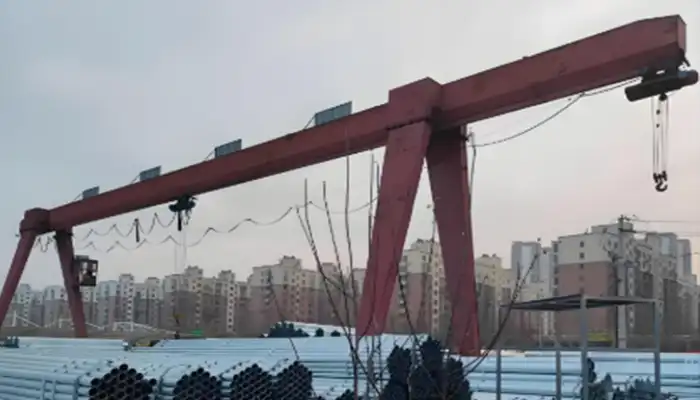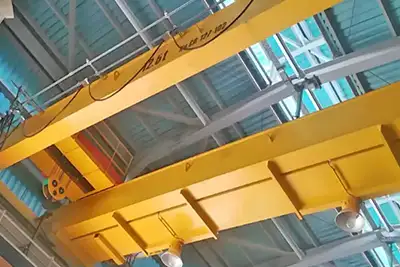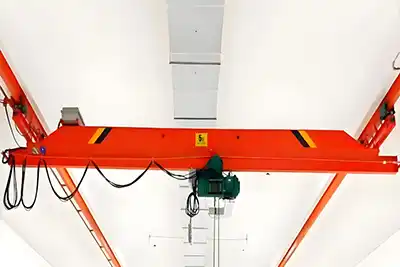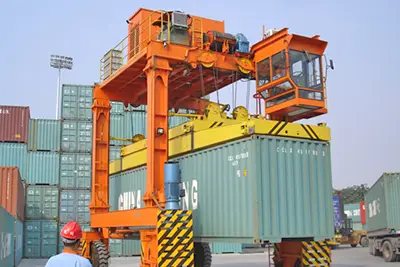Gantry Cranes for Steel Pipe Handling: Capacity & Configurations
5 Ton to 30 Ton Gantry Cranes for Steel Pipe and Tube Handling: Capacity and Configurations
Introduction
Handling long steel pipes and heavy tube bundles in open yards is not easy. You’re dealing with awkward shapes, unpredictable weather, and the need to move large volumes quickly and safely.
In most cases, these pipes can be anywhere from 6 to 18 meters long. When bundled, their weight can easily reach 30 tons or more. Add in the limited maneuvering space of many yards, and you’ve got a serious logistics challenge on your hands.
Why Gantry Cranes Work So Well Outdoors
Unlike overhead cranes that rely on a building structure, gantry cranes stand on their own. That’s one of their biggest advantages for outdoor work.
- No Building Required: Gantry cranes can operate directly on rails laid in the yard. You don’t need to invest in constructing a workshop or warehouse just to lift and move materials.
- Adaptable to Yard Layouts: Whether you have straight rows, scattered stock, or multiple storage lanes, the gantry crane can span over it. Its legs roll along the rails to reach anywhere in its coverage area.
- Designed for Harsh Conditions: Gantry cranes are built with outdoor use in mind. With options like rain-proof covers, IP65-rated electrical parts, and anti-rust coatings, they’re meant to keep working no matter the season.
- Handles Long and Heavy Loads with Ease: Unlike forklifts, which struggle with pipe length, gantry cranes lift from above. This gives better balance, reduces the risk of bending the pipe, and avoids ground obstacles.
In short, when you’re lifting pipes or tubes in an outdoor steel yard, a gantry crane gives you the reach, capacity, and control that forklifts and loaders just can’t match.
 box girder single girder gantry crane
box girder single girder gantry crane
Common Applications and Material Characteristics
Steel pipe and tube yards are busy, high-load environments. The materials stored here aren’t just heavy — they’re long, uneven, and sometimes difficult to grip. Gantry cranes play a central role in organizing, lifting, and loading these materials safely and efficiently.
Typical Products Handled
In outdoor storage yards, you’ll often see two types of materials being handled:
Single Long Steel Pipes: These can range from 6 meters to over 18 meters in length, depending on the industry. Oil and gas projects, structural steel fabrication, and large-scale construction jobs often require longer pipes that can't be easily split or bent during handling.
- Diameters may range from 2 inches (50 mm) up to over 24 inches (600 mm).
- Heavier wall thickness or higher grades of steel increase the weight per pipe significantly.
- Single pipe weights can range from a few hundred kilograms to over 5 tons.
Bundled Steel Tubes or Pipes: Most steel yards store pipes in bundles to speed up handling. These are often strapped together in sets of 5 to 30 pipes.
- Bundles may be uniform (same diameter and length) or mixed, depending on production or delivery schedules.
- They’re typically lifted using custom lifting beams, grabs, or slings designed to handle the full weight and length safely.
- Most bundles are between 5 and 30 tons in weight, depending on pipe specifications and quantity per bundle.
Handling either of these product types requires equipment that can adapt to long loads without causing bending, slipping, or damage.
Bundle Weights and Dimensions
Lifting capacity and spreader design both depend on knowing the weight and dimensions of your load — and this varies by product and storage method.
Weight Per Bundle
- Light-duty bundles: 5 to 10 tons (for small-diameter thin-walled tubes).
- Mid-range bundles: 10 to 20 tons (common in general construction supply).
- Heavy-duty bundles: 20 to 30 tons (used in pipeline, offshore, and heavy structure industries).
Bundle Length
- Usually matches standard steel pipe lengths: 6m, 9m, 12m, 18m, and sometimes longer for offshore and oilfield projects.
Bundle Width and Stack Height
- Bundle widths can vary from 0.5 meters to over 1.5 meters depending on pipe diameter.
- Stack height in storage yards typically ranges from 1.2 meters to 2.5 meters — but higher stacks are possible if yard space is limited.
Layout Considerations
- Yards are often arranged with parallel rows to allow gantry legs and rails to pass through.
- Storage planning must consider clearances for lifting devices and safe movement paths for trucks and trailers.
If you want to load a truck in 10 minutes instead of 30, you need a crane that matches the product’s shape, size, and handling style. Gantry cranes offer the adaptability and overhead reach that fixed-position equipment can't match.
Recommended Gantry Crane Capacities
Choosing the right gantry crane capacity isn’t just about lifting the heaviest load on-site. It’s about planning for daily work volume, space usage, and safety margin over time. A crane that’s too small will struggle and wear out faster. One that’s too large may cost more than needed and increase operating costs.
Standard Capacity Range: 10 to 60 Tons
Outdoor gantry cranes used in steel pipe and tube handling typically fall between 10 and 60 tons of lifting capacity. Your specific choice depends on a few key factors:
Load Type: Single Pipe vs. Bundled Pipes
- A single long pipe may weigh 1 to 5 tons, but its length and flexing risk mean it needs a longer spreader beam and controlled handling. You don't necessarily need high capacity here — just reach and stability.
- A pipe bundle, on the other hand, can weigh 10 to 30 tons or more. These require higher lifting capacity, especially when bundling mixed sizes or high-density steel grades.
Handling Frequency
- If you're moving 3–5 loads per hour, a smaller-capacity crane (10–20 tons) may work fine for light use.
- For high-throughput yards—especially loading/unloading trucks daily—go with 30–60 tons for efficiency and longevity.
Required Safety Margin
- It's good practice to select a crane rated at least 20–30% higher than your typical maximum load.
- This safety factor accounts for dynamic loads, lifting attachments, or unexpected extra weight due to mud, snow, or misdeclared shipments.
Duty Class and Usage Conditions
- Cranes operating outdoors with frequent cycles should be at least A5 to A6 duty class to withstand wear.
- Heavier operations (continuous work in large steel yards or ports) should aim for A7 or higher.
Practical Tip: If your maximum bundle weight is 24 tons and you lift 20 times a day, a 32-ton double girder gantry crane is a safe and flexible option that won’t be overworked.
truss girder gantry crane for bundles of pipes handling
Span and Lifting Height Considerations
The crane’s span and lifting height also affect its performance and fit for your yard.
Wide Spans for Yard Coverage
- 20 to 40 meters is the typical span range for gantry cranes in pipe storage yards.
- A wider span lets the crane straddle multiple storage lanes and allows for side-by-side truck or railcar loading.
- Keep in mind that longer spans may require a reinforced bridge girder or double girders for stability.
Lifting Height Suited to Application
- 6 to 12 meters lifting height is usually sufficient for pipe and tube handling.
- If stacking is involved (3–4 bundle layers), you may need a lifting height of 10 meters or more.
- For direct loading into flatbed trailers or containers, a lower lift height (6–8 meters) is often enough.
Ground Clearance and Truck Access
- The gantry legs should provide enough clearance for forklifts, trucks, and flatbed trailers to pass beneath, especially near loading zones.
- Always check your trailer height (typically around 1.2 to 1.5 meters) and ensure the crane can lift bundles high enough for safe placement.
Don't underestimate the importance of lifting height when planning for yard upgrades. If you stack higher or switch to larger trailers later, you'll want a crane that can still do the job without modification.
Key Advantages of Gantry Cranes in Pipe Yards
Pipe yards aren’t controlled environments. You’re dealing with wind, rain, dust, and limited space — all while lifting heavy and often awkward materials. That’s exactly where gantry cranes shine. They're designed to handle outdoor conditions, work around tight layouts, and adapt as your yard grows.
Outdoor Suitability
Steel pipe and tube handling is almost always done outdoors — and the crane must be ready for the elements.
- Weather-Resistant Build: Gantry cranes used in yards are typically made of structural steel with protective surface treatments like anti-rust primer + outdoor-grade paint. This helps prevent corrosion, especially in coastal or humid areas.
- Electrical System Protection: Key electrical components — including limit switches, control boxes, and motors — should be IP54 to IP65 rated, depending on your local climate. Higher IP ratings protect against water spray and dust infiltration.
- Optional Weather Covers: You can request rainproof covers for hoists, motor gearboxes, and even operator cabins. These covers extend equipment life and reduce maintenance frequency.
- Winter-Ready Options: In cold regions, anti-freeze grease, heating elements in motor housings, and cold-start capable electronics are practical add-ons worth including.
Ask your supplier to confirm local weather compatibility — especially if you operate in areas with heavy seasonal rains or sandstorms.
Space Efficiency
Yards are often tight on space. Pipe and tube stock is long, and ground space can fill up quickly. Gantry cranes help maximize every square meter.
- No Overhead Building Needed: Since gantry cranes operate on ground-level rails, you don’t need to construct a steel building or support columns. That’s a big savings in both money and layout restrictions.
- More Storage Underneath: Gantry cranes lift from above, not from the side. This means bundles can be stored directly below the crane’s coverage area without interfering with its operation.
- Reduced Ground Traffic: With lifting handled from above, there’s less need for forklifts or side loaders — minimizing the risk of collision, congestion, and ground wear.
- Better Yard Organization: Gantry cranes can travel the full length of the yard on rails, allowing better sorting and stacking by material type, size, or delivery schedule.
Operational Flexibility
One of the most practical reasons to use gantry cranes in pipe yards is their flexibility. They can move, grow, and adapt as your operation changes.
- Modular and Relocatable: Many gantry crane systems are bolted together, not welded. This allows for easy relocation or lengthening of rails as the yard expands.
- Custom Track Layouts: Ground rails can be installed on concrete beams, embedded sleepers, or even steel plates depending on soil conditions and budget.
- Handling Uneven Ground: If the site is slightly uneven or sloped, adjustable rail leveling pads and track grouting can still make gantry operation smooth.
- Multiple Cranes on One Rail: In high-volume yards, you can run two or more gantry cranes on the same rail system to cover more ground without buying oversized equipment.
Design your yard layout with future growth in mind. Leave room to extend rail tracks or increase crane span if your inventory increases over time.
electromagnetic spreader fro efficient long pipe bundles handling
Custom Lifting Attachments and Tools
When lifting steel pipes and bundled tubes, the crane alone is not enough. The right under-hook attachment is what makes the lift safe, stable, and efficient. Without a suitable lifting tool, you risk damaging the pipes — or worse, dropping the load.
Options for Safe Pipe Handling
Different lifting situations call for different tools. Whether you're handling single pipes or large bundles, you need attachments that match both the load and your workflow.
C-Hooks: Commonly used for lifting coil-shaped materials but can be customized for pipe bundles laid horizontally. Best for predictable, uniform bundles.
- Simple to use and fast in operations.
- Must match pipe width and weight closely.
Pipe Grabs / Mechanical Tongs: Designed to clamp down on pipe bundles from both sides or lift from the top. Some versions are hydraulically or pneumatically actuated.
- Great for varying pipe diameters.
- Can lift single pipes or full bundles depending on grip strength.
Lifting Slings: Nylon or steel wire slings are still widely used, especially for irregular or mixed bundles.
- Economical and flexible, but require skilled rigging.
- Can be time-consuming and prone to slipping if not used properly.
Spreader Beams: Ideal for very long loads like 12–18 meter pipes. The beam spreads the lifting points, reducing pipe bending or stress.
- Can be fixed or telescopic.
- Often used with multiple slings or lifting clamps.
For lifting long pipes, always use at least two lifting points to avoid bending. More points may be needed for heavy-wall or sensitive pipe products.
Features to Look For
Not all lifting tools are made the same. Some small design features can make a big difference in daily safety and productivity.
- Anti-Slip Surfaces: Rubber-lined jaws or grip pads reduce the risk of pipes slipping mid-lift, especially when surfaces are oily or dusty.
- Adjustable Widths: Pipe bundles don’t always come in standard sizes. Look for tools with manually or automatically adjustable arms to handle a range of diameters and widths.
- Automatic Centering and Balancing: Some attachments have self-balancing systems that keep the load level, even if weight distribution is uneven. This reduces the strain on riggers and improves lifting safety.
- Quick-Release or Semi-Automatic Hooks: These features reduce manual handling time and the need for workers to be near the load during hook-on and release operations.
Safety Enhancements
Modern pipe yards are under increasing pressure to reduce accidents and improve visibility during crane operations. These enhancements support safer and more precise lifting.
- Load Monitoring Systems: Installed on hoist trolleys or between the hook and attachment. These devices show real-time weight, overload alarms, and sometimes load position tracking. Useful for operators and maintenance teams.
- Onboard Cameras and Operator Monitors: Helpful when handling long pipes where part of the load may be out of the operator’s direct line of sight. Mountable on the trolley, hoist, or hook.Helps avoid collisions and improves loading alignment.
- Wireless Remote Control with Feedback: Some remotes provide vibration or sound feedback when a lift is complete or when a limit switch is triggered. This allows for one-person operation in many cases.
Using the right tool under the hook is just as important as choosing the right crane. It keeps the load secure, the pipe straight, and the workers safe.
Configuration Options
When planning a gantry crane system for steel pipe and tube handling, the crane’s structural type, movement layout, and control method all need to match your yard conditions and workload. There’s no one-size-fits-all design — each configuration offers trade-offs between cost, flexibility, and performance.
single girder gantry crane with double hoists for long steel pipe and tube handling , economcial solutions
Single vs. Double Girder Gantry Cranes
The first decision is whether to go with a single girder or double girder gantry crane. Each has its place depending on your lifting needs.
Single Girder Gantry Crane: A cost-effective choice for lighter loads and moderate usage.
- Best suited for lifting capacities up to 10–20 tons.
- Generally uses a hoist suspended under the girder, which simplifies the design and reduces weight.
- Easier to install and less expensive in terms of material and maintenance.
- Ideal for small yards or occasional pipe handling where budget is a key concern.
Double Girder Gantry Crane: Built for heavier loads, frequent use, and more complex lifting scenarios.
- Recommended for 20–60 tons capacity and beyond.
- Offers higher hook height (because hoist travels between the girders instead of under).
- Stronger and more stable — ideal for handling long pipe bundles, custom grabs, and spreader beams.
- Can support additional features like maintenance walkways, cabs, or auxiliary hoists.
If you're using a long lifting beam or need a higher lifting height to stack tall bundles or load trucks, go with a double girder design.
Full vs. Semi-Gantry
Next, choose the right gantry layout depending on how much space you have and whether you're working near buildings or fences.
Full Gantry Crane: This is the most common type in open yards. It has two legs running on parallel rails, fully spanning the yard.
- Provides maximum coverage and stability.
- Ideal for wide yards with multiple rows of pipe or tube bundles.
- You can lift from anywhere within the span, making storage and truck loading more flexible.
Semi-Gantry Crane: One side runs on a ground rail, and the other side rides along a wall-mounted rail or support beam.
- Useful when space is tight or when you want to save on one side of the crane structure.
- Often installed alongside a warehouse, fabrication workshop, or property line.
- Requires careful coordination between building structure and rail installation.
If your yard runs along an existing building, a semi-gantry crane can reduce installation costs and still give you high lifting capacity on one side.
Power Supply and Controls
Your crane can only work as efficiently as its power and control system allow. Here's what to consider:
Power Supply Systems
- Cable Reel System: A flexible solution where a drum automatically reels out or retracts the power cable as the crane moves. Best for medium spans and moderate movement lengths.
- Busbar System: A rigid conductor rail mounted along the gantry track. Ideal for longer spans and continuous use. Offers cleaner power delivery and is lower maintenance than cable reels.
Control Methods
- Pendant Control: Tethered to the crane, suitable for basic operations. Less common for pipe yards due to limited operator movement.
- Wireless Remote Control: Allows the operator to move freely for better visibility and safer distance during handling. Now widely used for both small and large gantry cranes.
- Cabin Operation: Typically installed on double girder cranes, where the operator sits in an enclosed cab mounted on the trolley. Recommended for heavy-duty pipe yards with high frequency of lifts or poor weather visibility.
If your yard is busy and you're lifting heavy or long pipes, combine wireless remote control with CCTV camera systems for improved handling safety and accuracy.
Conclusion
Steel pipe and tube yards are tough environments — long materials, outdoor exposure, and constant movement make efficient handling a challenge. Gantry cranes offer a practical, proven solution that fits the job.
They don’t need a building, they work well over wide areas, and they’re built to carry heavy, awkward loads like bundled or single pipes. Whether you’re stacking, sorting, or loading trucks, a properly configured gantry crane can drastically reduce downtime and manual handling.
Why Gantry Cranes Are Indispensable in Pipe Yards
- They handle heavy pipe bundles with less risk.: Unlike forklifts, gantry cranes lift from above, allowing smoother, safer movements.
- They cover large outdoor areas.: Full gantry types can span 20 to 40 meters or more — perfect for open yards where pipes are stored in rows.
- They’re built for the outdoors.: Weather-resistant components, sealed controls, and modular rail systems make them reliable in rain, sun, or dust.
Key Takeaways for Buyers
When selecting a gantry crane for steel pipes or tubes, focus on three key things:
- Capacity and Structure: Choose a double girder design for anything above 20 tons or if you need a custom lifting tool.
Match the crane’s span and height to your yard’s storage layout and truck clearance. - Safe and Efficient Lifting Attachments: Use pipe grabs, spreader beams, or slings designed for your specific product.
Look for features like anti-slip pads, balancing mechanisms, and load indicators to keep operations secure and reduce pipe damage. - Proper Configuration: Decide between full and semi-gantry layouts based on your yard shape.
Choose a busbar or cable reel system for power, and go for wireless remote control with visibility aids for better safety.
A good gantry crane is more than a lifting machine — it’s a daily workhorse that makes your yard faster, safer, and more productive.




